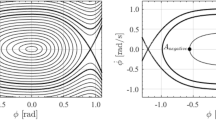Abstract
The formula to determine the roll angle for structural strength assessment in ClassNK’s Technical Rule and Guidance gives a value based upon maximum roll amplitude at probability of exceedance Q = 10–8 within the design life of ship on long-term prediction of roll amplitude. The long-term prediction is obtained from combining short-term prediction of roll amplitude and a probability of occurrence of short-term irregular sea in long term (design life of ship). In the current rule, non-linearity of roll is included as some correction coefficients obtained from model experiments and empirical knowledge at the time of development. However, the ships have considerably changed since then, and the coefficients are not always suitable for the novel vessels. The purpose of this study is to propose a rational short-term prediction method considering nonlinearity of roll. In this paper, applicability of a non-Gaussian PDF (Probability Density Function) for PDF of roll angle is investigated.
Access this chapter
Tax calculation will be finalised at checkout
Purchases are for personal use only
Similar content being viewed by others
References
Caughey TK (1963) Derivation and application of the Fokker-Planck equation to discrete nonlinear dynamic systems subjected to white noise random excitation. The Journal of the Acoustical Society of America 35(2):1683–1692
Kimura K, Sakata M (1980) Non-stationary responses of a non-symmetric non-linear system subjected to a wide class of random excitation. J Sound Vib 76(2):261–272
Kimura K (1995) Non-Gaussian equivalent linearization for estimation of stochastic response distribution of nonlinear systems (in Japanese). Transactions of the Japan Society of Mechanical Engineers Series C 61(583):831–835
Kimura K, Morimoto T (1998) Estimation of non-Gaussian response distribution of a nonlinear system subjected to random excitation (application to nonwhite excitation with nonrational spectrum (in Japanese). Journal of the Japan Society of Mechanical Engineers 64(617):1–6
Kimura K, Takahara K, Yamamoto S (2000) Estimation of non-Gaussian response distribution of a system with nonlinear dam** (in Japanese). Dynamics and Design Conference
Maki A (2017) Estimation method of the capsizing probability in irregular beam seas using non-Gaussian probability density function. J Mar Sci Technol 22(2):351–360
Maki A, Sakai M, Umeda N (2018) Estimating a non-Gaussian probability density of the rolling motion in irregular beam seas. J Mar Sci Technol 24(4):1071–1077
Sakata K, Kimura K (1979) The use of moment equations for calculating the mean square response of a linear system to non-stationary random excitation. J Sound Vib 67(3):383–393
Sakata K, Kimura K (1980) Calculation of the non-stationary mean square response of a non-linear system subjected to non-white excitation. J Sound Vib 73(3):333–343
St. Denis M, Pierson WJ (1953) On the motions of ships in confused seas. Transactions SNAME 61:280–357
To CWS (2017) Nonlinear random vibration: analytical techniques and applications, 2nd edn. CRC Press
Acknowledgements
Part of this research was supported by ClassNK.
Author information
Authors and Affiliations
Corresponding author
Editor information
Editors and Affiliations
Appendix
Appendix
Figure 10 shows a sample results of calculated variance of roll angle using time series roll motion data in various number of encounter waves. Concretely, a long time series data of roll angle was used in order from the first. σn and σ700 means the standard deviation calculated by the roll angle data for n and 700 encounter waves. This figure shows that the variance over n = 500 is almost converged.
Rights and permissions
Copyright information
© 2023 The Author(s), under exclusive license to Springer Nature Switzerland AG
About this chapter
Cite this chapter
Katayama, T., Kankaku, M., Maki, A., Sugimoto, K., Fukumoto, Y. (2023). Study on Short-Term Prediction of Roll in Beam Sea. In: Spyrou, K.J., Belenky, V.L., Katayama, T., Bačkalov, I., Francescutto, A. (eds) Contemporary Ideas on Ship Stability. Fluid Mechanics and Its Applications, vol 134. Springer, Cham. https://doi.org/10.1007/978-3-031-16329-6_9
Download citation
DOI: https://doi.org/10.1007/978-3-031-16329-6_9
Published:
Publisher Name: Springer, Cham
Print ISBN: 978-3-031-16328-9
Online ISBN: 978-3-031-16329-6
eBook Packages: EngineeringEngineering (R0)





